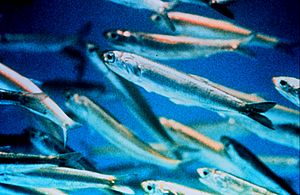Californian anchovy facts for kids
Quick facts for kids Californian anchovy |
|
|---|---|
 |
|
| Conservation status | |
| Scientific classification | |
| Kingdom: | |
| Phylum: | |
| Class: | |
| Order: | |
| Family: | |
| Genus: |
Engraulis
|
| Species: |
E. mordax
|
| Binomial name | |
| Engraulis mordax Girard, 1854
|
|
| Synonyms | |
|
|
The California anchovy or northern anchovy (Engraulis mordax) is a small, silvery fish. It lives in the Pacific Ocean, from Mexico all the way up to British Columbia in Canada. These fish are known for swimming in huge groups called schools.
Contents
Anchovies and People
People have used California anchovies for many years. They are important for both fishing industries and for fun.
Fishing for Anchovies
In the 1940s and 1950s, there were fewer sardines in the Pacific. So, people in America started catching more anchovies. They would can them for food. In 1946, about 960 tons of anchovies were caught. By 1953, this number grew to almost 43,000 tons!
From 1949 to 1955, California limited anchovy fishing. They could only be caught to use as bait fish. Today, most California anchovies are caught for animal feed. They are also used as bait for other fish. In 2010, American fishermen caught about 2,100 metric tons of these anchovies.
In July 2014, something amazing happened. A huge school of northern anchovies was seen off the coast of La Jolla. Scientists were very surprised. They said they had not seen such a large group in over 30 years!
Catching Anchovies for Fun
Many people enjoy fishing for anchovies. Anglers, or people who fish with a rod and line, catch them. They use anchovies as bait for bigger fish. Sometimes, they also catch them to eat themselves.
Where Anchovies Live
California anchovies live in the ocean. They prefer coastal waters, usually within 30 kilometers (about 18 miles) of the shore. Sometimes, they can be found much farther out, up to 480 kilometers (about 300 miles) from land. They also swim into bays and inlets.
These fish live in subtropical areas. You can find them from about 51°N latitude down to 21°N latitude. This range covers the Northeast Pacific. It stretches from northern Vancouver Island down to Cape San Lucas in Baja California, Mexico.
There are two main types, or subspecies, of California anchovies. One is Engraulis mordax mordax. It lives from British Columbia to Baja California. The other is Engraulis mordax nanus. This type is found in the bays of California.
What Do They Look Like?
California anchovies are small fish. They have a pointed snout. Their mouth, called a maxilla, is moderately sized. It reaches almost to the back of their cheek area. The tip of their lower jaw is below their nostril.
They have slender, long gill rakers. These are like combs that help them filter food from the water. Their anal fin starts under the last ray of their dorsal fin. A silver stripe runs along their side. This stripe often fades away as the fish gets older.
How Big Do They Get?
California anchovies can grow up to 24.8 centimeters (about 9.7 inches) long. However, they are usually around 15 centimeters (about 6 inches) long. The heaviest one ever recorded weighed about 68 grams (about 2.4 ounces). These fish can live for up to 7 years.
Anchovy Life
California anchovies form very large, tightly packed schools. This helps them stay safe from predators. They eat tiny ocean creatures. Their diet includes euphausiids, copepods, and decapod larvae. They catch food by filtering water and by picking out individual prey.
These fish lay their eggs in batches. The eggs float in the open ocean. Anchovies can spawn, or lay eggs, throughout the year. They usually have one peak spawning season. After being caught, anchovies are often processed into fishmeal. This is used as animal feed. They are also used as bait for tuna. Sometimes, they are even canned for people to eat.


